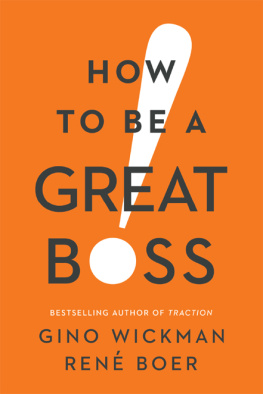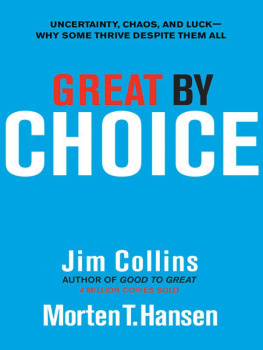
Simon & Schuster
1230 Avenue of the Americas
New York, NY 10020
www.SimonandSchuster.com
Copyright 2018 by Morten Hansen
All rights reserved, including the right to reproduce this book or portions thereof in any form whatsoever. For information, address Simon & Schuster Subsidiary Rights Department, 1230 Avenue of the Americas, New York, NY 10020.
First Simon & Schuster hardcover edition January 2018
SIMON & SCHUSTER and colophon are registered trademarks of Simon & Schuster, Inc.
For information about special discounts for bulk purchases, please contact Simon & Schuster Special Sales at 1-866-506-1949 or .
The Simon & Schuster Speakers Bureau can bring authors to your live event. For more information or to book an event, contact the Simon & Schuster Speakers Bureau at 1-866-248-3049 or visit our website at www.simonspeakers.com.
Interior design by Ruth Lee-Mui
Jacket Design by Adly Elewa
Library of Congress Cataloging-in-Publication Data is available.
ISBN 978-1-4767-6562-4
ISBN 978-1-4767-6583-9 (ebook)
For Hlne
ONE
THE SECRETS TO GREAT PERFORMANCE
After nine grueling interviews, I landed my dream job as management consultant at the Boston Consulting Group in London. Ill never forget how I showed up on my first day, wearing an elegant blue suit bought for the occasion, with Oxford lace-up shoes to match. My girlfriend had given me a sleek, soft briefcase of the sort bankers carried around. As I strode through the front doors of the office in posh Devonshire House, right near Piccadilly, I looked the part, but felt intimidated.
I yearned to make a mark, so I followed what I thought was a brilliant strategy: I would work crazy hours. I didnt have much relevant work experienceheck, I didnt have any. It was my first real job. I was twenty-four years old and had just finished a masters degree in finance from the London School of Economics. What I lacked in experience I would make up for by staying late in the office. Over the next three years, I worked sixty, seventy, eighty, even ninety hours per week. I drank an endless stream of weak British coffee and survived on a supply of chocolate bars I kept in my top drawer. It got to the point where I knew the names of the cleaning staff who arrived at five in the morning. As you can imagine, my girlfriend soon wanted the briefcase back.
One day, as I struggled through an intense merger and acquisition project, I happened upon some slides created by a teammate (Ill call her Natalie). Paging through her analysis, I confronted an uncomfortable truth. Natalies work was better than mine. Her analysis contained crisper insights, more compelling ideas. Her slides boasted a clean, elegant layout that was more pleasing to the eye and easier to comprehendwhich in turn made her analysis even more persuasive. Yet one evening in the office, when I went to look for her, she wasnt there. I asked a guy sitting near her desk where she was, and he replied that shed gone home for the night. He explained that Natalie never worked late. She worked from 8 a.m. to 6 p.m. No nights, no weekends. That upset me. We were both talented and had the analytical capability required of BCG consultants. She had no more experience in the field than I did. Yet she did better while working less.
Three years later, I left BCG to embark on an academic career. I earned a Ph.D. from Stanford University and went on to become a professor at Harvard Business School. From time to time, I found myself thinking back to what I called the Natalie Question: Why had she performed better in fewer hours? She must have carried some secrets explaining her results. I began to wonder about performance in general and decided to focus my research on corporate performance.
Starting in 2002, Jim Collins and I spent nine years working on our book Great by Choice as a sequel to Jims Good to Great . Both books offer empirically validated frameworks that account for great performance in companies . Thats nice if youre leading a business, but what about the rest of us? After we finished the project, I decided to develop a similarly validated framework for individual performance. It was time to discover why Natalie had done better than I, and more generally, to tackle the big question: why do some people perform great at work while others dont?
Social scientists and management experts explain performance at work by pointing to peoples innate gifts and natural strengths. How often These talent-based explanations are deeply embedded in our perceptions of what makes for success. But are they right?
Some work experts take issue with the talent view. They argue that an individuals sustained effort is just as critical or even more so in determining success.
Talent, effort, and also luck undoubtedly explain why some succeed and others dont, but I wasnt satisfied with these arguments. They didnt account for why Natalie performed better than I, nor did they explain the performance differences I had observed between equally hardworking and talented people.
I decided to take a different approach, exploring whether the way some people worktheir specific work practices as opposed to the sheer amount of effort they exertaccounts for greatness at work. That led me to explore the idea of working smart, whereby people seek to maximize output per hour of work . The phrase work smarter, not harder has been thrown around so much that it has become a clich. Who wants to work dumb? But many people do in fact work dumb because they dont know exactly how to work smart. And I dont blame them, because its hard to obtain solid guidance.
I scanned for existing advice on how to work smarter, and the picture I arrived at was incoherent and overwhelming. Every author seemed to say something different. Prioritize. Delegate. Keep a calendar. Avoid distractions. Set clear goals. Execute better. Influence people. Inspire. Manage up. Manage down. Network. Tap into passion. Find a purpose. The list went on, more than 100 pieces of advice.
So what is really going on? If Natalie worked smarter than I, what exactly did she and other top performers do? What secrets to their great performance do they harbor? I decided to find out. After years of study, what I found surprised me a great deal and shattered conventional wisdom.
THE PERFORMANCE STUDY
In 2011, I launched one of the most comprehensive research projects ever undertaken on individual performance at work. I recruited a team of researchers with expertise in statistical analysis and began generating a frameworka set of hypotheses about which specific behaviors lead to high performance. I considered the scattered findings I had found in more than 200 published academic studies, and I incorporated insights from my previous discussions with hundreds of managers and executives. I also drew on in-depth interviews with 120 professionals and undertook a 300-person survey pilot. In the final step, we tested the emerging framework in a survey study of 5,000 managers and employees.
To organize the vast array of potential work smart factors, I grouped them into categories that scholars regard as important for job performance. We can think of work as consisting of job design characteristics ( what a person is supposed to do), skill development ( how a person improves), motivational factors ( why a person exerts effort), and relational dimensions (with whom and how a person interacts). Once I had settled on these broad categories, I examined factors within each, identifying those that previous research suggested were key. (The research appendix contains details on our methodology.)







